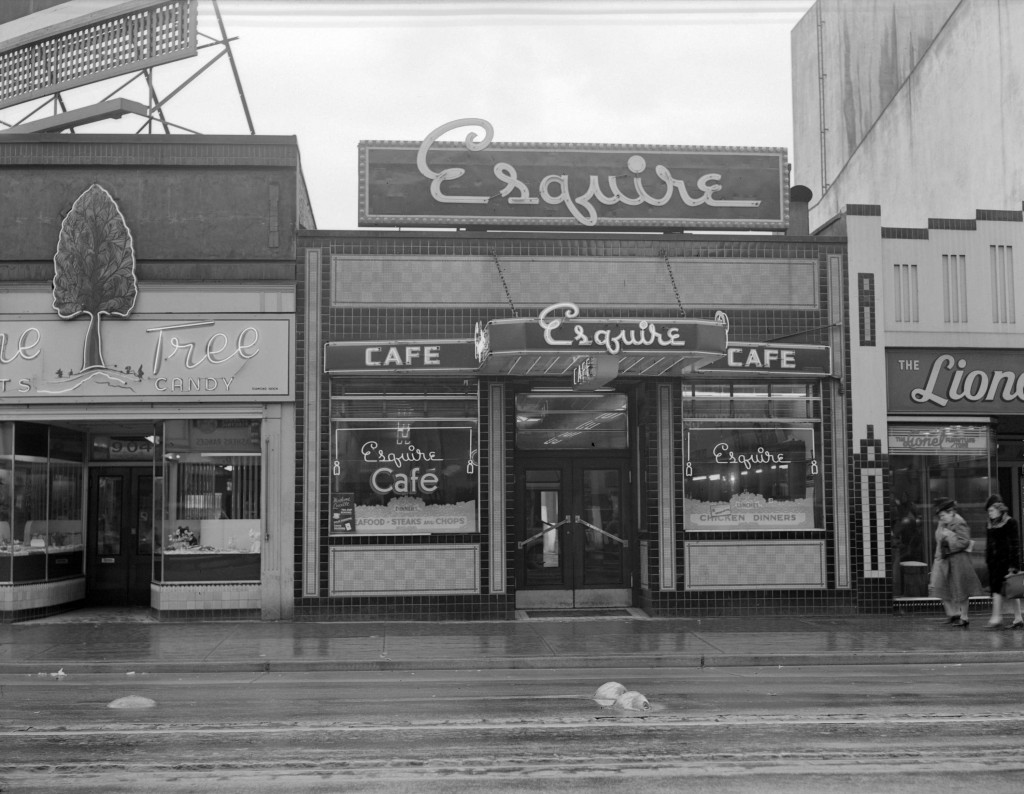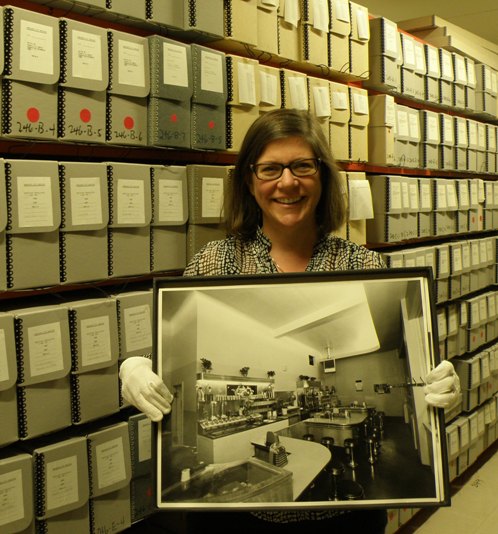This post was written by Christine Hagemoen.
As a volunteer at the Archives, I was recently tasked with sorting through boxes that contained display materials and photo enlargements from previous Archives exhibits and displays (pre-Internet days). The object was to find interesting content for possible Authenticity blog posts. One of the boxes was marked “Diners” and as a food history buff I was immediately intrigued. Curiously, the box only contained two photo enlargements. I was immediately drawn to this image of the White Lunch from 1918.

White Lunch Ltd. No. 4, 806 Granville St. Vancouver, B.C., 8 Mar. 1918. Stuart Thomson, photographer. Reference code: AM1535-: CVA 99-5167
The photograph shows the rather elegant interior of the White Lunch including customers, servers, menu and prices. In 1918, you could get a bacon & egg sandwich for 15 cents, oyster stew for 25 cents, and a hot clubhouse sandwich for 35 cents.
My curiosity was piqued, so I decided to search the Archives’ database for more images. I started by using the subject term “Restaurants, diners, lunchrooms, etc.” to find out what and where Vancouverites were eating in the 20th century.

Hollywood Cafe at 872 Granville Street – lunch counter, Apr. 21, 1936. Stuart Thomson, photographer. Reference code: AM1535-: CVA 99-4883
The Hollywood Café, with its long lunch counter and art deco interior, was located between the Commodore Ballroom and the Orpheum Theatre on Granville Street in the heart of Vancouver’s theatre district.

The Esquire Cafe, 906 Granville Street, between 1940 and 1948. Jack Lindsay, photographer. Reference code: AM1184-S1-: CVA 1184-3378
This elegantly named Esquire Café was located very near to the fashionable Vogue Theatre, allowing theatregoers a chance to grab a meal pre or post cinema. A sign in the window advertises teacup readings by Madame Lucille.

Interior view of a diner, Oct. 1942. Jack Lindsay photographer. Reference code: AM1184-S3-: CVA 1184-1407
This photograph shows waitresses in matching service uniforms serving customers at the counter. Notice how many customers are smoking at the counter.

Paris Cafe exterior, 438 Pender Street West, 1932. Stuart Thompson photographer. Reference code: AM1535-: CVA 99-2646
The three-storey building that housed the Paris Café is still standing, however the building on the right (another café called Three Girls Lunch) has been torn down, and is now a parking lot.
As advertised by the numerous signs in the window, the following was available at the Paris Café in June of 1932:
- whole can of shrimps with potato salad for 25 cents
- Breaded Pork Cutlets with country gravy for 20 cents
- Sunday Chicken Dinners (“well balanced and carefully prepared”) 50 cents, and
- a special menu of hot weather salads.

400 West Pender Street south side, May 27, 1974. Reference Code: COV-S509-: CVA 778-275
This image from 1974 features the Pender Place Restaurant (424 West Pender Street), a Canadian, Greek and Chinese family restaurant. The right side of the image shows the entrance at 438 West Pender, the site of the former Paris Café.

Marine Cafe at 936 West Pender Street. July 7, 1931. Stuart Thompson photographer. Reference code: AM1535-: CVA 99-3964
In similar fashion to the Paris Café, the Marine Café, also on Pender Street, proudly displayed in the window the various specials on offer. Apparently the “best value in the city” in 1931 was its “Merchants Lunch” – 35 cents for soup, entrée, dessert and drink.

Man standing outside shallow building at Pender and Carrall Streets, 1936. Reference code: AM54-S4-: Bu N158.3
This photograph from the 1930s shows a man standing at the counter of a fast food restaurant located in a building that is six feet deep. This food counter was located in the well-known Sam Kee Building at 8 West Pender, considered to be the shallowest commercial building in the world.

“The Original” Old Country Fish and Chips store, 6 East Hastings Street, 1923. Stuart Thomson, photographer. Reference code: AM1535-: CVA 99-3455
This fish and chips café was located on East Hastings at Carrall Street, right beside the Pennsylvania Hotel. It was also conveniently located to serve the nearby B.C. Electric Railway (BCER) Company Terminal building and its workers at 425 Carrall Street, shown below in the following decade.

The Tram News Stand and Coffee Shop illuminated at night in the B.C. Electric Building at 425 Carrall Street, 1937. James Crookall, photographer. Reference code: AM640-: CVA 260-778

B.C. Telephone employees in the staff cafeteria. August, 1947. Jack Lindsay photographer. Reference code: AM1184-S1-: CVA 1184-2889
Some fortunate workers like these B.C. Telephone employees above could enjoy meals in a staff cafeteria. They did not need to venture very far to enjoy a hot meal or beverage.

B.C. Electric Railway Company News Stands- lunch counter, 1921. Stuart Thomson, photographer. Reference code: AM1535-: CVA 99-3551
In 1927, commuters could enjoy some refreshments like ginger wine, malted milk shakes and Bovril (beef tea). Also on offer at this small news stand lunch counter, sardine sandwiches for 15 cents.

Canadian Youth Hostel bike hike at concession stand, July 1943. Donn B.A. Williams, Don Coltman, photographers. Reference code: AM1545-S3-: CVA 586-1339
Like lunch counters, concession stands were located to serve the public snacks and beverages as they went along enjoying some leisure time. Hot dogs, hamburgers and ice cream were popular foods to serve people on the go.

Cook and woman in concession stand, 1938. James Crookall, photographer.
Reference code: AM640-: CVA 260-938

Almond’s Ice Cream Store, English Bay, ca. 1920. Stuart Thomson, photographer. Reference code: AM1535-: CVA 99-3097
Located right across from English Bay on Beach Avenue, Almond’s Ice Cream Parlor was ideally situated to capitalize on the beach-going public. Portable treats like hot roasted peanuts and “Butterkrisp” popcorn (roasted by electricity!) were also on offer at Almond’s. You can see a corner of the iconic Sylvia Hotel in the left background.

Woman using pineapple juice vending machine at the Hudson’s Bay store, Sept. 20, 1933. Stuart Thomson, photographer. Reference code: AM1535-: CVA 99-4559
The intent of novelties like this pineapple juice vending machine was to not only provide refreshments to shoppers already in the store, but also to attract shoppers to the store. In the 1930s, thirsty Hudson’s Bay shoppers could try a delicious drink of ice-cold pure Hawaiian pineapple juice for 5 cents.
We have photographs from Vancouver’s fast food history from many eras. Take a look and tell us if you remember any!
Christine Hagemoen has been volunteering at the Archives since the fall of 2012. A born-and-raised Vancouverite, Christine holds a BA (Art History ) from UBC, and a Diploma of Professional Photography and a Library and Information Technology diploma, both from Langara College. Until recently, Christine worked as a Media Librarian at the CBC Vancouver media archives. In 2012, Christine curated a Vancouver Heritage Foundation public art exhibit titled “Room at the Roxy”. Her keen interest in visual history and dedication to preserving her hometown’s history inspired Christine to volunteer at the Archives.

Christine Hagemoen with one of the prints that inspired her to write this post about Vancouver’s diners. Photograph by Cindy McLellan.

























































